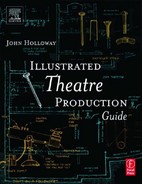PREFACE
Working in the theatre is fun. Or at least it should be. Theatre people are bright, hardworking, and committed to an artistic pursuit. If not, they would never survive the long hours and hard work that a theatre career demands. It is not a job for wimps. I have always enjoyed the way that “show business” changes from day to day. It is not your normal 9-to-5 job, and you get to meet all sorts of interesting people and be involved in wonderfully zany situations. Once backstage at a production of Nutcracker I overheard the stage manager make this call to the dressing rooms: “Tiny mice and toy soldiers go to stage left. Tiny mice and toy soldiers go to stage left.” Suddenly it occurred to me that there is no other occupation where you would hear someone say that. And best of all, there was soon a flood of small children in furry costumes.
Many times I have been privileged to see an audience greatly moved by a performance that I have helped to create. It is always so fulfilling to see that people's lives have been enriched by your own work.
This book started life as a journal. It was meant as a companion to a stagecraft class I often teach. Since then, it has grown into what you are holding in your hands. It is full of very specific information, and is intended for people who actually want to make things. It provides step-by-step instructions with lots of illustrations so that you can see visually what the narrative is talking about. Since it began as a journal, the drawings are mostly small thumbnails of the sort you would jot down as idea illustrations in a sketchbook. Much of it is written in the first or second person. That is, “I” talk about something that “YOU” can make happen yourself, and it is a direct result of teaching class and talking to students. My class tends to be very hands-on. We talk about things first, but later there is always a project to use that knowledge in a practical way. Learning by doing is an important philosophy. You can study music theory, but it would be hard to learn to play the piano without actually sitting down at the keys and practicing.
I WOULD LIKE TO THANK…
There have been so many people who have helped make this book a reality and deserve a word of thanks. First of course, would be the students in my classes over the years who have questioned me about practically everything since day one. That has really kept me on my toes, and made me want to learn more myself. Teachers often say that they learn so much from their students, and I am sure that to someone who has never taught that must be puzzling. But it is so true. You never understand something fully until you have to teach it to someone else.
I would like to thank the editors at Focal Press for having faith in the work: Marie Lee, and especially Diane Wurzel, for convincing their bosses to take a chance on this book, which is so different from the others.
My teaching colleagues Geri Maschio and Pat White for reading through some very tedious rough drafts, before there were so many diverting drawings, and Marilyn Hamann for suggesting them. Thanks to Marty Golia for double checking me on electrical theory. Thanks to Michael Lavin, Robert Jackson, Ricka White, Clay Watkins, and Bob Kinstle for being encouraging and making suggestions.
Many thanks to the members of IATSE local 346 for putting up with me talking about this for so long, and for allowing me to use their picture in the introduction.
A great debt is owed to Tom and Ann Barry for teaching me so much about the touring business. I was really green starting out, and they put up with me anyway. Special thanks to Ann for not firing me after the horrible incident in Minneapolis. (I swear to God, it looked like the right purchase line to me!) Thanks to Nanette Golia, Nick Rouse, and Mark Krauss, for teaching me how to behave on tour.
If you would like to contact me about this book, my email address is: [email protected]
The poem on the next column is from the November 3, 1894 edition of the New York Clipper., which was a newspaper of that time. It is funny how things have not really changed all that much over the years. Although wages have gone up somewhat from “five bones” a week (whatever that means!) since then. The IATSE was founded four years later in 1898. Perhaps that helped to boost salaries.

